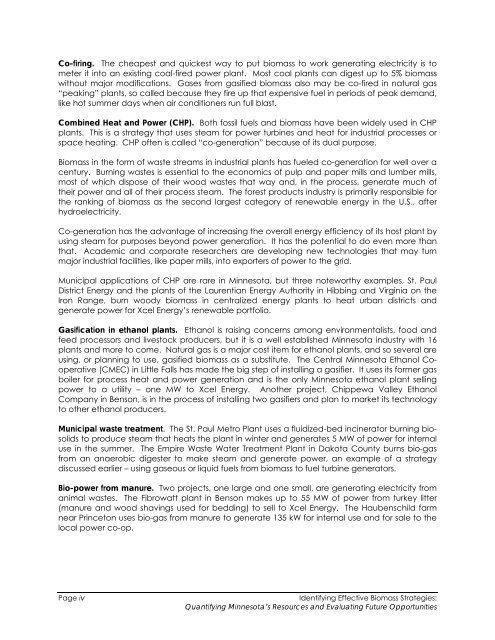Biomass Feasibility Project Final Report - Xcel Energy
Biomass Feasibility Project Final Report - Xcel Energy
Biomass Feasibility Project Final Report - Xcel Energy
You also want an ePaper? Increase the reach of your titles
YUMPU automatically turns print PDFs into web optimized ePapers that Google loves.
Co-firing. The cheapest and quickest way to put biomass to work generating electricity is to<br />
meter it into an existing coal-fired power plant. Most coal plants can digest up to 5% biomass<br />
without major modifications. Gases from gasified biomass also may be co-fired in natural gas<br />
“peaking” plants, so called because they fire up that expensive fuel in periods of peak demand,<br />
like hot summer days when air conditioners run full blast.<br />
Combined Heat and Power (CHP). Both fossil fuels and biomass have been widely used in CHP<br />
plants. This is a strategy that uses steam for power turbines and heat for industrial processes or<br />
space heating. CHP often is called “co-generation” because of its dual purpose.<br />
<strong>Biomass</strong> in the form of waste streams in industrial plants has fueled co-generation for well over a<br />
century. Burning wastes is essential to the economics of pulp and paper mills and lumber mills,<br />
most of which dispose of their wood wastes that way and, in the process, generate much of<br />
their power and all of their process steam. The forest products industry is primarily responsible for<br />
the ranking of biomass as the second largest category of renewable energy in the U.S., after<br />
hydroelectricity.<br />
Co-generation has the advantage of increasing the overall energy efficiency of its host plant by<br />
using steam for purposes beyond power generation. It has the potential to do even more than<br />
that. Academic and corporate researchers are developing new technologies that may turn<br />
major industrial facilities, like paper mills, into exporters of power to the grid.<br />
Municipal applications of CHP are rare in Minnesota, but three noteworthy examples, St. Paul<br />
District <strong>Energy</strong> and the plants of the Laurentian <strong>Energy</strong> Authority in Hibbing and Virginia on the<br />
Iron Range, burn woody biomass in centralized energy plants to heat urban districts and<br />
generate power for <strong>Xcel</strong> <strong>Energy</strong>’s renewable portfolio.<br />
Gasification in ethanol plants. Ethanol is raising concerns among environmentalists, food and<br />
feed processors and livestock producers, but it is a well established Minnesota industry with 16<br />
plants and more to come. Natural gas is a major cost item for ethanol plants, and so several are<br />
using, or planning to use, gasified biomass as a substitute. The Central Minnesota Ethanol Cooperative<br />
(CMEC) in Little Falls has made the big step of installing a gasifier. It uses its former gas<br />
boiler for process heat and power generation and is the only Minnesota ethanol plant selling<br />
power to a utility – one MW to <strong>Xcel</strong> <strong>Energy</strong>. Another project, Chippewa Valley Ethanol<br />
Company in Benson, is in the process of installing two gasifiers and plan to market its technology<br />
to other ethanol producers.<br />
Municipal waste treatment. The St. Paul Metro Plant uses a fluidized-bed incinerator burning biosolids<br />
to produce steam that heats the plant in winter and generates 5 MW of power for internal<br />
use in the summer. The Empire Waste Water Treatment Plant in Dakota County burns bio-gas<br />
from an anaerobic digester to make steam and generate power, an example of a strategy<br />
discussed earlier – using gaseous or liquid fuels from biomass to fuel turbine generators.<br />
Bio-power from manure. Two projects, one large and one small, are generating electricity from<br />
animal wastes. The Fibrowatt plant in Benson makes up to 55 MW of power from turkey litter<br />
(manure and wood shavings used for bedding) to sell to <strong>Xcel</strong> <strong>Energy</strong>. The Haubenschild farm<br />
near Princeton uses bio-gas from manure to generate 135 kW for internal use and for sale to the<br />
local power co-op.<br />
Page iv<br />
Identifying Effective <strong>Biomass</strong> Strategies:<br />
Quantifying Minnesota’s Resources and Evaluating Future Opportunities

















